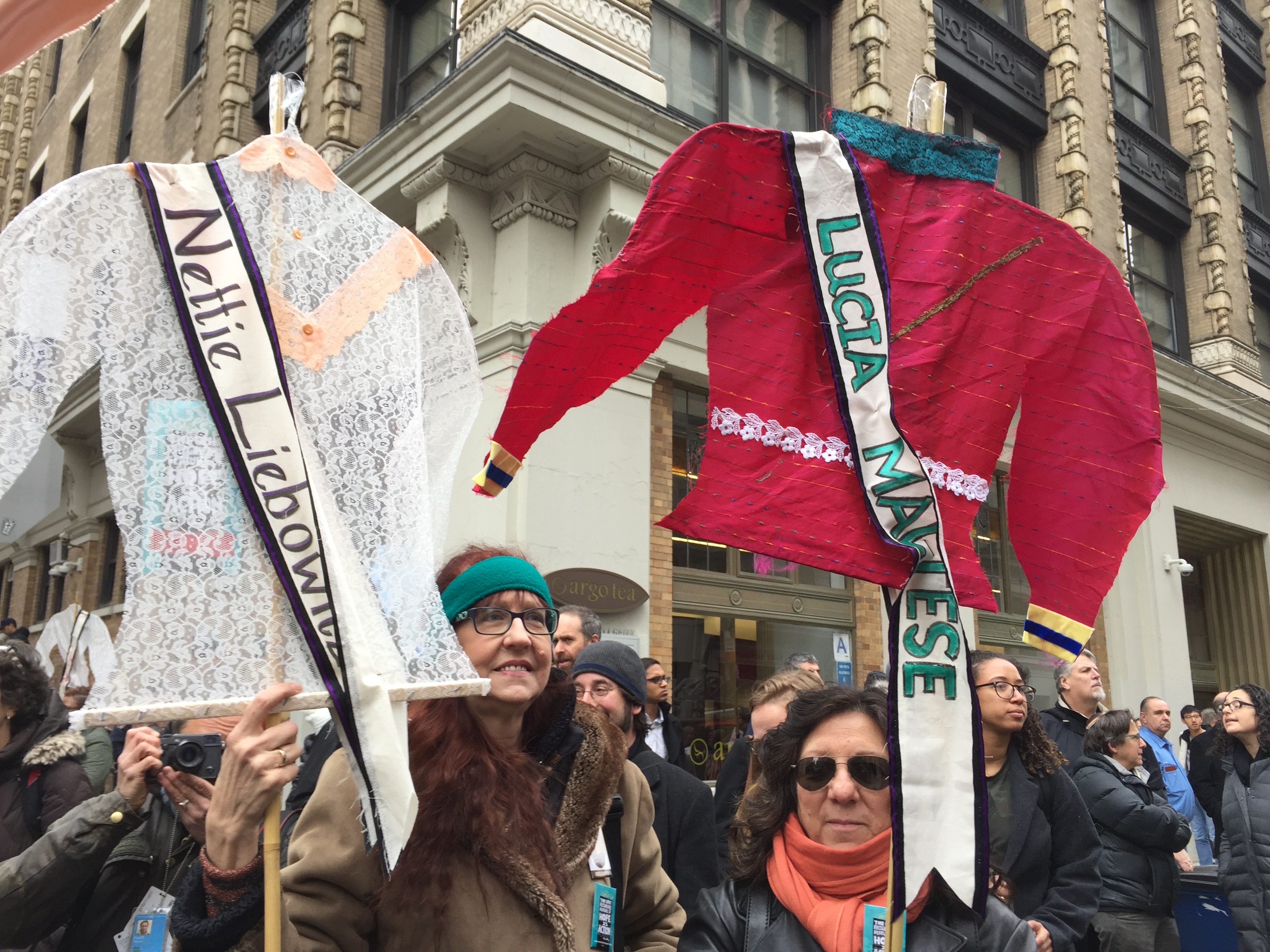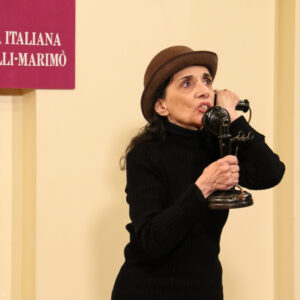During the cold day of Friday March 24th, a group of people gathered on Washington Square south, in front of the Brown Building as they do once a year. They carry shirts as banner with names of young women like Lucia Maltese, 20, and Providenza Panno, 43, in commemoration of a terrible event that happened 106 years ago: the Triangle Shirtwaist Factory Fire.

The Triangle Fire is a tragedy that happened on March 25th, 1911, when 146 workers, mostly young immigrant women, particularly from Italy and Eastern Europe, died. Every year, a labor union march is held in front of what used to be the shirt-waist factory. The event commemorates the women who lost their lives due to bad working conditions and their legacy.
Those 146 workers lost their lives due to a lack of safety regulation in the workplace. Exits were routinely locked from the outside in the factory, which was the case that Saturday when the fire started on the eighth floor. The fire started on the eight floor and soon reached the ninth and tenth floors of the 10-story building. Most of the workers from the eight floor managed to reach the fire exits, but those soon collapsed under the weight of the fleeing women. The structure was not equipped with any overhead sprinkles and the tallest ladder of the fire department could only reach the sixth floor, leaving the seamstresses with the choice to either jump out of the windows or be burned alive. Mostly women died in this tragedy, but 23 men did too. Other men, like Joseph Zito, an elevator operator, greatly contributed to saving many workers, risking his life going up and down several times from the ninth floor, trying to save as many lives as possible, until the elevator chord burned.
Not only were many of these women not supposed to be there on a Saturday, but they were there because the owners were trying to recuperate profits losses due to a strike organized, not too long before, by those same women who were demanding improved safety in the working place.
“I sew and I am in a union, I get paid good wages and work in a safe environment, these young girls didn’t have that opportunity” says Susan Joy Checksfield, a shirt-holder, who has been attending the commemoration since 2009 and holding a shirtwaist banner for Nettie Liebowitz, one of the victims of the fire. It is common for repeat participants to adopt a particular victim and represent them during the commemoration. But Susan not only represents Nettie in the march, but she also got involved with Nettie’s descendants, met them and had their permission to represent Nettie as long as she’s able to come to the memorial ceremony. And this is exactly the link between this catastrophe and its commemoration: the continuous fight of the workers of New York for better wages and safer working conditions.
Almost all of the speakers pointed out the importance of fighting the employers’ motto “Profit over people” and push the “safety first” agenda, especially for New York workers. Many of the fire regulations of this state, indeed, came after the Triangle Fire tragedy, but the battle is not over yet. Over the past year 31 construction workers, who were working mostly working on non-union job-sites, died in New York. Using Fraser Ottanelli’s, a shirt-holder, words: “We’re here to reaffirm that we’re determined to keep on fighting for workers’ rights.”

The commemoration went on later that afternoon at NYU Casa Italiana Zerilli-Marimò, with “Remember the Triangle Fire” an event organized by Valeria G. Castelli and the Remember the Triangle Fire Coalition, and co-sponsored by NYU Casa Italiana, the Italian American Writers Association and National Organization of Italian American Women.
The event started with an excerpt of Lulu Lolo Pascale’s “Soliloquy for a Seamstress: The Triangle Shirtwaist Factory Fire,” a one-woman piéce about the terrible events, impersonating first Serafina Saracino, a Triangle seamstress, then a reporter narrating the catastrophe as he witnessed it.

Lulu Lolo’s remarkable performance was followed by the screening of “Triangle,” Costanza Quatriglio’s documentary that draws a moving parallel between the 1911 Fire and the collapse of a textile factory in Barletta, Italy, in 2011. The documentary shows how much there is to be done still and how we are still struggling 100 years later.
After the screening, Mary Anne Trasciatti, Chair of the Remember the Triangle Fire Coalition, explained the past, present and future project of the coalition, including the realization of a memorial site on the building. Many people not only ignore the disaster that disturbed the public psyche in 1911 and started women’s and labor movements in the city, but do not even know that the building is still standing at the corner of Washington Pl. and Greene St. and it’s now a NYU building for science. People pass by and many students attend classes in the building everyday, and they do not even have the foggiest idea of the historical importance of that building.
The Coalition wants to insure that everyone who comes across the former Triangle Factory knows about its historical relevance. For this reason, the Coalition started to plan a memorial site in 2010, but the installation of the memorial site was caught up in red tape. In those seven years, a lot has been done. The memorial design has been selected after a 2013 competition, defining Richard Joon Yoo and Uri Wegman as winners.
The installation consists of an interactive composition which will include all the names of the workers who died that March 24th. It also uses the sunlight to draw the observers into the sculpture and make them empathize with the 146 victims. NYU has already given permission for the installation of such a memorial on its building – which has never happened before. Also, in 2015, Gov. Cuomo granted 1.5 Million dollars to the realization of this memorial, making this project possible. However, the Coalition is aware that at least an additional million needs to be raised in order to allow the maintenance of the sculpture after its installation.

Ms. Trasciatti explains: “We want to remember the 146 deaths and their legacy in the political activism that emerged after the fire.” And again: “those who saw the fire were determinate to do something” and that’s what the Coalition hopes to accomplish through the sculpture, to involve the observer and continue this activism.
The memorial site not only wants to promote awareness about this disaster for workers, but awareness about others that are still happening in the 21st century: Barletta in 2011, the Dhaka fire in 2012 and the Savar building collapse in 2013are only a few of them.
And the sculpture is only one of the pieces of art used to raise awareness: plays, a quilt which represents all the work environment disasters, the shirtwaists and a street art project in which the names of the victims of the Triangle fire were written in chalk in front of their residence all over NYC.

It is important to raise awareness for this tragedy and make it as prevalent as it was immediately following, but above all make sure that the victims of the numerous tragedies related to poor working conditions have an impact. The Triangle Fire gave us a legacy of fighting for workers’ rights which we need to continue.












